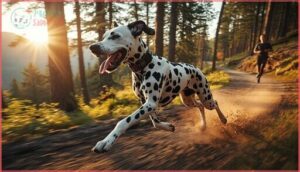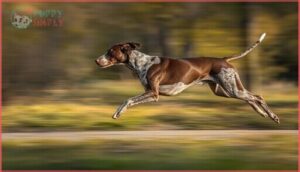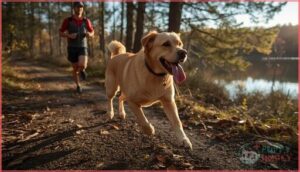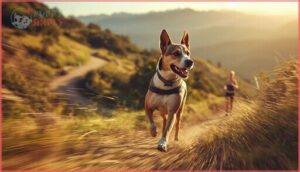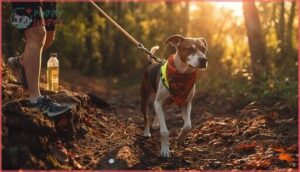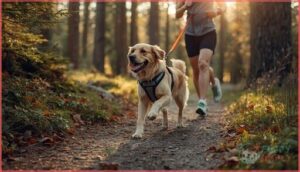This site is supported by our readers. We may earn a commission, at no cost to you, if you purchase through links.
Your dog glances at your running shoes, tail already wagging in anticipation. That daily three-mile loop you’ve been tackling solo doesn’t have to be a lonely endeavor anymore. The right canine companion won’t just keep pace—they’ll match your stride, boost your motivation, and turn every run into an adventure you both look forward to.
But not every breed can handle the physical demands of regular distance running. Some dogs lack the endurance for sustained activity, while others overheat quickly or struggle with joint stress on hard pavement. Choosing a running partner requires understanding which breeds possess the stamina, body structure, and temperament to thrive alongside you mile after mile.
This guide breaks down the top breeds built for running, along with essential training tips and health considerations to keep both of you safe and strong.
Table Of Contents
- Key Takeaways
- Key Traits of Great Running Dog Breeds
- Best Large Breeds for Running Companions
- Top Medium and Small Breeds for Runners
- Health and Safety Considerations for Running Dogs
- Tips for Training Your Dog to Run
- Frequently Asked Questions (FAQs)
- How do I introduce my dog to running if they’ve never done it before?
- What are the signs that my dog is overexerting themselves during a run?
- How often should I run with my dog weekly?
- Can puppies start running at any age?
- What signs indicate my dog is overheating?
- Should I feed my dog before or after running?
- Are certain paw pad types better for running?
- Conclusion
Key Takeaways
- Successful running dogs need specific physical traits like stamina over 2+ hours daily, lean muscle mass above 70%, and proper body structure (35-60 pounds ideal), with breeds like Border Collies, Vizslas, and Labrador Retrievers excelling due to their cardiovascular systems and hunting heritage.
- Training must follow a gradual 10% weekly mileage increase starting around 12-18 months after growth plate closure, with 3-4 weekly sessions of roughly 27 minutes to build endurance while monitoring fatigue signs like excessive panting, lagging, or gait changes.
- Heat tolerance varies dramatically by breed—Bulldogs face 17 times higher heatstroke risk than average dogs, while breeds like Rhodesian Ridgebacks and Vizslas handle warm climates better, making climate matching essential for safety.
- Joint health requires proactive care including veterinary checkups before starting, joint supplements for breeds prone to hip dysplasia, appropriate surface selection to prevent paw pad burns (asphalt can exceed 122°F), and hydration up to 40% above the standard 1 ounce per pound daily requirement.
Key Traits of Great Running Dog Breeds
Not every dog is built to hit the pavement with you, and understanding what makes a good running companion can save you both from frustration and injury down the road.
Certain physical and behavioral traits separate breeds that thrive on miles from those better suited for shorter, gentler activities.
Let’s break down the key characteristics you should look for when choosing a four-legged running partner.
Stamina and Endurance
Endurance separates casual joggers from true running companions. You need a dog breed that sustains pacing over long distances without breaking down, like Border Collies and Siberian Huskies with their superior cardiovascular systems. These breeds excel at distance training and energy conservation, maintaining activity for 2+ hours daily.
Labrador Retrievers, known for their athleticism, are often considered top running breeds. Proper breed recovery and hydration strategies become essential when your companion runs consistent mileage alongside you.
Energy Levels and Drive
Beyond sheer stamina, you’re looking at breed energy and genetic predisposition to sustained drive. Border Collies need 2–3 hours of intense activity daily, while Jack Russell Terriers demand 1–2 hours to satisfy their heightened motivation factors. High-energy dogs like Belgian Malinois thrive with task-focused outlets, and life stage matters—adolescent dogs peak in activity demands. Under-stimulated breeds risk behavioral issues, so matching dog exercise needs to breed suitability prevents frustration for both of you. For example, Golden Retrievers benefit from one and a half hours of daily activity.
- Border Collies requiring intense mental and physical challenges
- Terriers exhibiting persistent movement from strong hunting drive
- Siberian Huskies craving endurance-based sled-pulling work
- Herding breeds displaying over 80% engagement in routine runs
- Sporting breeds needing retrieval or tracking activities consistently
Temperament and Trainability
High energy won’t cut it if your dog won’t listen. Breed intelligence matters, but socialization impact during puppyhood shapes behavioral consistency more than genetics alone—only 9% of dog behavior links directly to breed suitability. Sporting breeds excel with positive reinforcement, making dog training smoother.
Herding breeds like Border Collies show over 80% command responsiveness, while scenthounds score around 40% due to their nose-driven independence.
| Breed Group | Trainability Score |
|---|---|
| Herding breeds | 70%+ |
| Sporting breeds | 75%+ obedience |
| Terrier breeds | Variable, high prey drive |
| Scenthounds | ~40%, independent |
Climate and Terrain Adaptability
Your running environment matters as much as trainability when choosing dog breeds. Labrador Retrievers score 4.9 out of 5 for climate adaptability, thriving in warm climates and cold weather alike.
Heat tolerance varies widely—Vizslas and Rhodesian Ridgebacks handle hot runs better than double-coated breeds. Cold resilience peaks in Huskies and German Shepherds.
Terrain versatility separates trail runners from pavement pounders, with Weimaraners and Rhodesian Ridgebacks excelling on rocky surfaces. Adaptability trends show working breeds dominating multi-environment performance.
Size and Muscular Build
Body structure determines whether your dog can keep pace with your running goals. Ideal bodyweight ranges from 35 to 60 pounds for most athletic breeds, balancing speed with stamina. Muscle composition and breed standards directly affect stride efficiency and injury risk.
- Lean body mass ratios above 70% improve endurance in running dog breeds
- Large breeds like Weimaraners exceed 60 pounds while maintaining athletic builds
- Muscle tone constitutes over 54% of total body mass in top performers
- Deep chests and narrow waists boost lung capacity during runs
- Muscular hindquarters provide powerful acceleration in sporting dog breed characteristics
Best Large Breeds for Running Companions
If you’re looking for a running partner who can handle serious mileage, large breeds often make the best choice. These dogs have the stamina, build, and drive to keep up with your training routine, whether you’re logging easy miles or pushing the pace.
Let’s look at five large breeds that excel as running companions and what makes each one stand out.
Weimaraner – Energy and Distance
If you’re searching for a dog that can match your pace on long runs, the Weimaraner is hard to beat. These powerful athletes boast a lean muscular build designed for endurance, with sprint speeds reaching 30-35 miles per hour. Their hunting heritage means they’re built for sustained running over long distances.
You’ll need to commit to 1-2 hours of vigorous daily exercise, but their impressive trainability makes them superb running companions.
Dalmatian – Stamina and Versatility
The Dalmatian’s carriage dog history explains why this breed makes an outstanding running companion. With top speeds hitting 37 miles per hour and endurance bred to match horses over miles, these spotted athletes thrive on vigorous exercise.
Their energy level management requires regular intense activity to prevent behavioral issues. You’ll find their athletic build bolsters both explosive sprints and sustained distance running across varied terrains.
German Shorthaired Pointer – Athleticism
This German Shorthaired Pointer’s lean, muscular frame and long legs deliver remarkable speed and agility across diverse terrains. Their hunting heritage built high endurance that translates perfectly into a running companion role.
You’ll need to support your athletic dog’s muscle health with a protein-rich dietary needs plan. Their eagerness to please makes training regimen conditioning straightforward, helping these gun dog breeds excel as your running partner.
Rhodesian Ridgeback – Power and Heat Tolerance
The Rhodesian Ridgeback’s heritage in hot African climates makes this breed ideal if you’re looking for heat adaptation in a running companion. Their muscular strength and moderate to high endurance support running distances in warm climates many dog breeds can’t handle.
Consider these climate suitability factors:
- Performs best between 15 and 60°F but tolerates higher temperatures
- Requires strategic timing to avoid midday heat stress
- Needs consistent hydration needs monitoring during runs
- Built for sustained power rather than speed alone
Labrador Retriever – Endurance and Friendliness
Labrador Retrievers can hit speeds up to 35 miles per hour and usually handle 4 to 5 miles per session, though training extends this to 10 miles or more. Their water retrieval background gives them natural endurance, making them one of the best dog breeds for running companions.
| Running Feature | Capability | Considerations |
|---|---|---|
| Distance capacity | 4-5 miles untrained, 10+ trained | Gradual increase prevents injury |
| Speed potential | Up to 35 mph | Strong leg muscles support terrain |
| Joint health needs | Prone to hip dysplasia | Joint supplements recommended |
| Weight management | Essential for longevity | Monitor diet with running distances |
Their friendly temperament means you won’t face temperament concerns during group runs.
Top Medium and Small Breeds for Runners
You don’t need a large breed to find your perfect running partner. Medium and small dogs can be just as capable, often bringing impressive speed, agility, and endurance to your runs.
Here are five breeds that pack serious athletic ability into more compact frames.
Vizsla – Speed and Adaptability
If you’re looking for a true athlete, the Vizsla endurance and speed are tough to beat—these dogs can hit 40 mph and comfortably handle 5-6 miles most days.
Their hunting instincts and enthusiastic Vizsla temperament make adaptability training straightforward, though they’ll need a jacket in cold weather.
At 18 months, they’re ready to become your dedicated running partner.
Border Collie – Intelligence and Agility
Border Collies bring serious brainpower to your runs—they’re one of the smartest dog breed intelligence options, with natural herding instincts that channel beautifully into structured exercise. At 18 kg and maintaining 2.32 m/s trotting speed, they excel at:
- Agility training on varied terrain
- Mental stimulation through route changes
- Energy management during sustained runs
Their herding dog breeds background means training challenges exist, but their responsiveness makes them remarkable partners.
English Springer Spaniel – Motivation and Enthusiasm
If you’re drawn to gun dog breeds with steady enthusiasm, English Springer Spaniels offer remarkable field-bred endurance and springer stamina. These medium-sized hunting dogs (40–50 pounds) work in a distinctive quartering pattern across terrain, maintaining a motivated pace throughout your run.
Their patient temperament makes dog training and behavior straightforward, while their exercise needs—ideal for short to moderate distances—match perfectly with consistent runners seeking dog breeds for exercise partnerships.
Jack Russell Terrier – Small Size, Big Energy
Jack Russell Terriers pack relentless Terrier Energy Levels into compact frames, routinely covering 5 km then bouncing into more play. Their high energy levels demand Consistent Stimulation through structured runs, though their strong Prey Drive Training needs careful attention—recall can falter off-leash.
These Small Dog Agility champions excel at interval training, making them ideal dog breeds for exercise if you can match their Activity Requirements with daily physical and mental challenges.
Greyhound – Speed and Moderate Needs
Greyhounds hit Racing performance peaks near 43.6 mph but surprise runners with their modest Exercise requirements outside the track. Their Biomechanical efficiency—Path optimization smooths movement at nearly 3.0 m/s³ jerk—makes them surprisingly gentle running companions for moderate distances.
These dog breeds pair sprint capability with calm Temperament traits, meeting dog exercise needs without extreme demands, supporting overall dog health through balanced activity.
Health and Safety Considerations for Running Dogs
Before you lace up your running shoes and clip on that leash, there are some important health factors you need to think about. Your dog’s safety depends on understanding their physical limits, breed-specific needs, and environmental challenges.
Let’s walk through the key areas that’ll help keep your running partner healthy and injury-free.
Age and Physical Readiness
Your dog’s age matters more than you might think when it comes to running. Puppies shouldn’t start regular runs until growth plate closure is complete, usually around 12–18 months depending on breed maturity rates. Starting too early increases puppy running risks and injury prevention concerns.
Senior dogs need careful assessment too, as their limits differ. Always schedule a physical checkup with your veterinarian before lacing up together.
Joint and Muscle Health
Running puts serious stress on your dog’s joints and muscles, especially in breeds with orthopedic damage risks like hip dysplasia. Joint supplements and muscle recovery days aren’t optional—they’re essential injury prevention tools.
Regular physical checkups with your veterinarian help catch breed predispositions early.
The exercise impact on dog health considerations matters: balanced routines strengthen supporting muscles while protecting vulnerable tissues from overuse.
Temperature Tolerance and Coat Type
Your dog’s coat type directly affects thermal regulation during runs. Double-layered coat breeds trap internal heat—surface temperatures can spike 17°C warmer inside the coat. Bulldogs face 14 times higher heatstroke risk than average breeds, while Chow Chows carry 17 times the danger.
Double-coated breeds trap dangerous internal heat during runs, with Bulldogs and Chow Chows facing up to 17 times higher heatstroke risk than average dogs
Cold endurance varies too: short-haired dogs need protection below 5°C. Breed adaptations matter—match coat insulation to your climate before hitting the trail.
Hydration and Nutrition Needs
Active dogs need about 1 ounce of water per pound of body weight daily, but running can push that requirement 40% higher. Even mild dehydration risks increasing body temperature and compromising performance during dog health and fitness activities.
You’ll also need to watch electrolyte balance—sodium, chloride, and magnesium drop through panting.
Caloric demands may double during training, so adjust macronutrient ratios with your vet.
Essential Running Gear for Dogs
Your dog’s gear matters just as much as your own running shoes. A well-fitted chest plate comfort reduces neck strain, while bungee leash types absorb sudden pulls. Dog booties protect paws from hot pavement and rough trails.
Collapsible dog hydration packs keep water accessible every 15 minutes. Don’t forget visibility gear like reflective chest plates or cooling vests for temperature regulation during extended runs.
Tips for Training Your Dog to Run
Training your dog to run with you takes patience, consistency, and a smart approach that protects their growing bones and joints. You can’t just clip on a leash and expect your pup to handle a 5K on day one—building up their stamina slowly is key to preventing injuries and burnout.
Here’s how to turn your four-legged friend into a reliable running partner who’s as excited about morning miles as you are.
Gradual Conditioning and Distance
Just like human athletes, your dog’s body needs time to adapt to the demands of endurance running. Start with short distances—around 3 km per week—and increase mileage by no more than 10% each week. This approach promotes injury prevention and lets muscles, joints, and cardiovascular systems strengthen safely.
To track your dog’s readiness for long-distance running, watch for these behavioral changes and performance metrics:
- Reduced pre-run restlessness – Dogs show less agitation and posture-shifting as stamina improves
- Consistent enthusiasm – Your partner maintains energy throughout runs without lagging
- Decreased voluntary activity on run days – A sign they’re appropriately challenged, not overtrained
Aim for 3–4 sessions weekly, with each lasting around 27 minutes. This consistency builds cardiovascular fitness without risking overtraining signs like persistent fatigue or reluctance to exercise. Research shows dogs following structured progression reach over 35 km per week within ten weeks while displaying fewer conflict behaviors and better focus.
Remember, gradual conditioning isn’t just about distance—it’s about building a foundation that bolsters your dog’s exercise needs for years of healthy running training together.
Leash Training and Obedience
Strong leash manners keep both you and your dog safe during runs, especially in high-traffic areas where sudden pulls can cause falls. Use positive reinforcement techniques—rewarding your dog for walking calmly without tension on the leash.
Herding breeds like Border Collies need more patient, structured approaches, while companion breeds respond quickly to affection-based methods.
Practice consistently between runs, focusing on obedience commands like “heel” and “come” to build reliable behavior.
Monitoring Behavior and Fatigue
Once leash skills are solid, watch how your dog manages the physical work. You need to catch fatigue indicators before they become problems. Recognizing these signs protects your canine companion from overexertion and keeps running performance safe:
- Excessive panting beyond normal breathing patterns
- Lagging behind or refusing to maintain pace
- Poor posture with arched back or unstable gait
- Loss of focus and ignoring familiar commands
- Excessive thirst signaling hydration monitoring needs
Behavioral techniques like observing gait changes help you apply mitigation strategies early, adjusting intensity based on what you see rather than sticking to fixed distances during dog training sessions.
Adjusting to Different Running Surfaces
Surface temperature risks vary dramatically depending on terrain, so you need to be mindful of paw pad conditioning. Asphalt and artificial grass can reach over 122°F, causing burns in minutes.
Start with gradual surface introduction on cooler natural grass, then slowly expose your dog to dirt and pavement. Watch for surface preference signs like limping or hesitation—these are injury prevention strategies you shouldn’t ignore when running with dogs.
When to Consult Your Veterinarian
Before your first run together, schedule a health checkup with your veterinarian. This is especially important if your dog is under two years old, since growth plates aren’t fully closed yet.
Watch for red flags during exercise: excessive panting, muscle stiffness, performance changes, or paw pad injuries all need immediate attention. Heat stroke symptoms—body temperature above 105°F—require emergency care.
Frequently Asked Questions (FAQs)
How do I introduce my dog to running if they’ve never done it before?
Like warming up before a sprint, introduce running gradually through 5-minute walk-jog intervals. Start puppies at twelve months, watch for fatigue signs, and choose soft surfaces during initial training sessions.
What are the signs that my dog is overexerting themselves during a run?
Watch for excessive panting, drooling, or limping—signs of heat stress and muscle fatigue. Paw pad damage, reluctance to continue running, and behavioral changes like irritability indicate your dog needs rest and hydration immediately.
How often should I run with my dog weekly?
Think you can just lace up and hit the pavement daily with your pup? Most healthy dogs thrive with three to four weekly runs, balancing exercise requirements with important rest days to prevent overtraining and injury.
Can puppies start running at any age?
No, puppies shouldn’t start running until skeletal maturity—usually 12 to 18 months depending on breed size. Growth plate closure must occur first.
Always get veterinary consultation before beginning any puppy training routine involving running.
What signs indicate my dog is overheating?
Your dog’s body sends distress signals you can’t ignore: frantic panting, bright red gums, drooling, weakness, vomiting, or disorientation.
These warnings escalate quickly in warm climates, demanding immediate cooling and veterinary attention.
Should I feed my dog before or after running?
You should feed your dog after running, waiting 30 to 60 minutes post-exercise. Pre-run feeding increases digestion risks like bloat, especially in large breeds. Follow veterinary guidelines for proper timing.
Are certain paw pad types better for running?
Compact cat feet offer enhanced endurance and stability, while elongated hare feet enable faster sprints.
Webbed paws provide traction on slippery terrain but may lack grip on hard surfaces, making pad type advantages terrain-dependent.
Conclusion
The best running partner might be the one who never complains about your pace. Selecting dog breeds that make good running companions means matching energy to endurance, temperament to terrain, and enthusiasm to your own commitment.
You’ve learned which breeds thrive on pavement and trail, how to protect growing joints, and when to slow down. Now lace up those shoes, clip that leash, and discover what happens when fitness becomes a shared journey—one where both of you come home stronger.
- http://www.funpawcare.com/bios/
- https://run.outsideonline.com/get-all-the-latest-from-your-running-community/
- https://www.outsideonline.com/2079536/why-youll-always-go-faster-partner
- https://ultimatedirection.com/dog-vest/?sku=1038&gclid=Cj0KCQjwo6D4BRDgARIsAA6uN18wslygu0YnKZb_pvz4UEMj20pXYA08zDky446bkAj8BseRQQdMaZAaAoVfEALw_wcB&ref=blog.therunexperience.com
- https://fave.co/3u8FWRX



